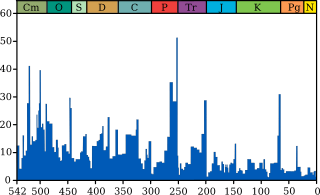List of extinction events facts for kids
This article lists times in Earth's history when many types of living things disappeared forever. These are called extinction events. Some were huge, wiping out most life on the planet, while others were smaller. Scientists often talk about the "Big Five" mass extinctions, which were the most severe. Understanding these events helps us learn about Earth's past and how life can change.
"Big Five" major extinction events
| Time Period | Extinction Event | When it Happened | What Caused It |
|---|---|---|---|
| Quaternary | Holocene extinction | From about 12,000 years ago to today | Mostly caused by humans and their activities. |
| Quaternary extinction event | 640,000, 74,000, and 13,000 years ago | Scientists are not sure, but it might have been climate changes, huge volcanic eruptions, or even humans hunting too much. | |
| Neogene | Pliocene–Pleistocene boundary extinction | 2 million years ago | Possibly a supernova (an exploding star) or a space rock hitting Earth (the Eltanin impact). |
| Middle Miocene disruption | 14.5 million years ago | Climate change because ocean currents changed. Earth's natural wobbles might have also played a part. | |
| Paleogene | Eocene–Oligocene extinction event | 33.9 million years ago | Many things happened at once: the Earth got colder, ice sheets grew at the poles, sea levels dropped, and a big space rock hit (the Popigai impactor). |
| Cretaceous | Cretaceous–Paleogene extinction event | 66 million years ago | A giant space rock hit Earth, creating the Chicxulub crater. Huge volcanism that formed the Deccan Traps might have also made things worse. |
| Cenomanian-Turonian boundary event | 94 million years ago | Most likely underwater volcanoes in the Caribbean. This caused the Earth to warm up and the oceans to become acidic. | |
| Aptian extinction | 117 million years ago | The cause is unknown, but it might be linked to volcanoes in the Rajmahal Traps. | |
| Jurassic | End-Jurassic (Tithonian) | 145 million years ago | This is now seen as many smaller events, not one big one. It was caused by space rock impacts, huge lava flows, climate changes, and problems in the oceans. |
| Pliensbachian-Toarcian extinction (Toarcian turnover) | 186-178 million years ago | Caused by the formation of the Karoo-Ferrar Igneous Provinces, which were huge volcanic eruptions. | |
| Triassic | Triassic–Jurassic extinction event | 201 million years ago | Possible causes include slow climate changes, volcanoes from the Central Atlantic magmatic province, or a space rock hitting Earth. |
| Carnian Pluvial Event | 230 million years ago | Caused by huge lava flows (the Wrangellia flood basalts) or the rising of mountains (the Cimmerian orogeny). | |
| Olenekian-Anisian boundary event | 247 million years ago | The oceans became too acidic. | |
| Smithian-Spathian boundary event | 249 million years ago | Late eruptions from the Siberian Traps volcanoes. | |
| Griesbachian-Dienerian boundary-event | 252 million years ago | More late eruptions from the Siberian Traps volcanoes. | |
| Permian | Permian–Triassic extinction event | 252 million years ago | This was the biggest extinction! It was likely caused by massive volcanic eruptions from the Siberian Traps. Other ideas include a space rock impact, oceans without oxygen, or an Ice age. |
| End-Capitanian extinction event | 260 million years ago | Volcanoes from the Emeishan Traps caused the Earth to get colder and other problems. | |
| Olson's Extinction | 270 million years ago | The cause is unknown, but it might have been a change in climate. | |
| Carboniferous | Carboniferous rainforest collapse | 305 million years ago | Possibly a series of fast climate changes, or volcanoes from the Skagerrak-Centered Large Igneous Province. |
| Serpukhovian extinction | About 325 million years ago | The start of a long ice age called the Late Paleozoic icehouse. | |
| Devonian | Hangenberg event | 359 million years ago | Oceans without oxygen, possibly linked to an ice age or volcanic activity. An exploding star (supernova) is also a possibility. |
| Late Devonian extinction (Kellwasser event) | 372 million years ago | Caused by volcanoes (the Viluy Traps) or possibly a space rock impact (the Woodleigh Impactor). | |
| Taghanic Event | About 384 million years ago | Oceans without oxygen. | |
| Kačák Event | About 388 million years ago | Oceans without oxygen. | |
| Silurian | Lau event | 420 million years ago | Changes in sea level and ocean chemistry? |
| Mulde event | 424 million years ago | A worldwide drop in sea level? | |
| Ireviken event | 428 million years ago | Deep oceans without oxygen. Earth's natural wobbles might have played a role. | |
| Ordovician | Late Ordovician mass extinction | 445-444 million years ago | The Earth got colder and sea levels dropped. Or, it might have been global warming linked to volcanism and oceans without oxygen. |
| Cambrian | Cambrian–Ordovician extinction event | 488 million years ago | Possibly caused by huge lava flows from the Kalkarindji Large Igneous Province. |
| Dresbachian extinction event | 502 million years ago | ||
| End-Botomian extinction event | 517 million years ago | ||
| Precambrian | End-Ediacaran extinction | 542 million years ago | Oceans without oxygen. |
| Great Oxygenation Event | 2400 million years ago | Rising oxygen levels in the air because of new life forms that used photosynthesis. This was also a time of a possible "Snowball Earth" event (see: Huronian glaciation). |
Timeline

All content from Kiddle encyclopedia articles (including the article images and facts) can be freely used under Attribution-ShareAlike license, unless stated otherwise. Cite this article:
List of extinction events Facts for Kids. Kiddle Encyclopedia.

